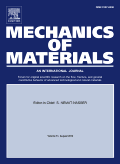
MECHANICS OF MATERIALS
Scope & Guideline
Shaping the Future of Mechanics with Cutting-Edge Studies
Introduction
Aims and Scopes
- Multiscale Material Modeling:
Research often involves multiscale approaches that integrate various modeling techniques, including atomistic, mesoscopic, and continuum mechanics to understand material behavior across different scales. - Mechanical Properties of Advanced Materials:
The journal publishes studies on the mechanical properties of a wide range of materials, including metals, polymers, composites, and biomaterials, often focusing on their behavior under complex loading and environmental conditions. - Damage and Failure Mechanisms:
A significant focus is placed on understanding damage evolution and failure mechanisms in materials, including fatigue, fracture, and other degradation processes. - Experimental and Numerical Simulations:
Papers frequently employ a combination of experimental techniques and numerical simulations to validate theoretical models and provide a comprehensive understanding of material behavior. - Innovative Material Design:
Research often emphasizes the design and optimization of new materials and structures, including bioinspired and architected materials, to achieve desired mechanical properties and functionalities.
Trending and Emerging
- Machine Learning in Material Mechanics:
There is a growing trend in utilizing machine learning techniques to predict material behaviors, optimize designs, and analyze complex datasets, showcasing the integration of computational intelligence with traditional mechanics. - Biomimetic and Nature-Inspired Materials:
Research on materials that mimic natural structures and behaviors is on the rise, reflecting an interdisciplinary approach that combines biology with materials science to develop innovative mechanical solutions. - Electromechanical Coupling Effects:
Papers focusing on the interaction between mechanical and electrical properties in materials, particularly in smart materials and structures, are increasingly prevalent, highlighting the importance of multifunctional materials. - Thermo-Mechanical Behavior of Materials:
Studies examining the effects of temperature and thermal cycling on material properties and performance are trending, particularly in the context of energy applications and high-temperature environments. - Additive Manufacturing and Its Impacts:
The exploration of materials specifically designed for additive manufacturing processes, including their mechanical properties and performance, is emerging as a significant area of focus within the journal.
Declining or Waning
- Traditional Metal Forming Processes:
There has been a noticeable decrease in publications focusing solely on classical metal forming processes, as newer methodologies and materials are gaining more attention. - Basic Elasticity Theory:
Papers that solely explore fundamental elasticity theory without application to advanced materials or structures are becoming less common, indicating a shift towards more complex and applicable studies. - Simple Homogenization Techniques:
Research utilizing basic homogenization techniques without consideration of advanced factors like microstructural effects or complex loading conditions is less frequently published, as more sophisticated approaches are preferred.
Similar Journals

FATIGUE & FRACTURE OF ENGINEERING MATERIALS & STRUCTURES
Decoding the Science of Structural IntegrityFATIGUE & FRACTURE OF ENGINEERING MATERIALS & STRUCTURES, published by WILEY, is a leading journal in the domains of materials science and mechanical engineering, with a solid reputation for advancing research on the behavior of materials under fatigue and fracture conditions. With an impressive impact factor and ranking in the top quartiles of its categories in 2023, this journal serves as a vital resource for academics, professionals, and students interested in the intricate mechanics of materials. The journal encompasses a comprehensive scope, covering both experimental and theoretical methodologies designed to understand and predict material performance under various loading conditions. As the journal continues to thrive since its inception in 1979 and is set to converge until 2024, it remains an essential platform for disseminating innovative and crucial findings in this specialized field. Researchers are invited to explore the wealth of knowledge presented within its pages, paving the way for enhanced engineering practices and material design.

International Journal of Mechanics and Materials in Design
Advancing the Frontiers of Mechanics and Material DesignInternational Journal of Mechanics and Materials in Design is a leading publication in the field of mechanical engineering and materials science, published by Springer Heidelberg. With an impressive impact factor, it holds esteemed rankings as Q1 in both Mechanical Engineering and Mechanics of Materials, and Q2 in Materials Science for the year 2023, solidifying its reputation as a significant contributor to the advancement of design methodologies. The journal focuses on the intersection of mechanics and materials, encouraging innovative research that addresses contemporary challenges faced in engineering disciplines. Researchers and professionals alike can benefit from accessing cutting-edge studies contributing to various applications, making it an invaluable resource for staying informed in this dynamic field. While the journal operates under a subscription model, its comprehensive reviews and high-quality original research foster a deeper understanding of material behavior and design principles, thus supporting the academic growth and professional development of its readers.
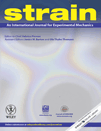
STRAIN
Fostering Excellence in Mechanics of MaterialsSTRAIN is a prestigious peer-reviewed journal published by WILEY, dedicated to advancing the field of mechanical engineering and mechanics of materials. With an ISSN of 0039-2103 and an E-ISSN of 1475-1305, STRAIN has been a pivotal resource for researchers and professionals since its inception in 1965. As of 2023, it holds a commendable categorization in the Q2 quartile rankings for both Mechanical Engineering and Mechanics of Materials, reflecting its significant contribution to the field and ranking in the top percentile of its category. STRAIN aims to disseminate high-quality, innovative research that enhances the understanding of strain phenomena and materials behavior under various conditions. Researchers seeking to publish cutting-edge studies will find a welcoming platform in STRAIN, where they can share their insights with a global audience committed to the evolution of engineering practices. Although it does not offer an Open Access option, its robust editorial standards ensure that all published works adhere to the highest levels of academic integrity and scientific rigor.

STRENGTH OF MATERIALS
Advancing the frontiers of material strength research.STRENGTH OF MATERIALS is a prestigious journal published by SPRINGER that focuses on the critical field of mechanics of materials, providing an authoritative platform for the dissemination of research and developments in material strength analysis since 1969. With an ISSN of 0039-2316 and an E-ISSN of 1573-9325, this journal serves a global audience of researchers, professionals, and students, contributing essential insights into the physical properties and performance characteristics of various materials under stress and strain. As part of the United States' academic literature, it showcases work that not only advances theoretical knowledge but also applies to practical engineering scenarios. Although ranked in the Q4 tier with respect to its category in Mechanics of Materials, with a Scopus rank of #319 out of 398 (19th percentile), it remains an important resource for those looking to expand their understanding in this specialized area. Researchers can access a wealth of information through this journal, fostering continued innovation and interdisciplinary collaboration.
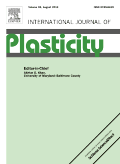
INTERNATIONAL JOURNAL OF PLASTICITY
Charting New Territories in Plasticity ExplorationINTERNATIONAL JOURNAL OF PLASTICITY, published by Pergamon-Elsevier Science Ltd, stands as a pivotal forum in the field of materials science and engineering, exploring the nuances of plastic behavior in materials. With its ISSN 0749-6419 and E-ISSN 1879-2154, this esteemed journal has been a cornerstone of academic research since its inception in 1985, continuing to hold significant relevance as it converges towards 2024. Ranking in the Q1 quartile across multiple categories, including Materials Science (Miscellaneous), Mechanical Engineering, and Mechanics of Materials, it is recognized for its high impact, evidenced by its competitive Scopus rankings that place it in the 97th percentile among mechanical engineering journals. Although it does not offer open access, the journal remains committed to disseminating cutting-edge research findings that advance understanding in plasticity, providing researchers, professionals, and students with vital insights into contemporary issues and innovations in the field.
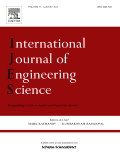
INTERNATIONAL JOURNAL OF ENGINEERING SCIENCE
Shaping the Future of Engineering Through Rigorous ResearchInternational Journal of Engineering Science, published by Pergamon-Elsevier Science Ltd in the United Kingdom, stands as a premier platform for pioneering research in the diverse fields of engineering and materials science. Since its inception in 1963, this journal has consistently demonstrated its commitment to advancing academic discourse, maintaining an impressive trajectory that positions it in the Q1 category across multiple engineering disciplines including Mechanical Engineering and Mechanics of Materials as of 2023. With notable Scopus rankings—placing it in the top 5% percentile for Mechanical Engineering and related fields—this journal attracts high-quality, impactful research designed for both industry practitioners and academic scholars. Although it does not currently offer Open Access options, its readership is enriched by comprehensive peer-reviewed articles, fostering a deeper understanding of complex engineering problems and innovative solutions. The International Journal of Engineering Science continues to be an invaluable resource for researchers, professionals, and students committed to pushing the boundaries of knowledge in engineering and materials science.
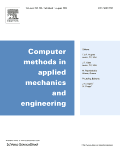
COMPUTER METHODS IN APPLIED MECHANICS AND ENGINEERING
Exploring Innovations at the Intersection of Engineering and Computation.COMPUTER METHODS IN APPLIED MECHANICS AND ENGINEERING, published by Elsevier Science SA, is a premier journal that has significantly contributed to the fields of computational mechanics, computer science applications, mechanical engineering, and the mechanics of materials since its inception in 1972. With an ISSN of 0045-7825 and an E-ISSN of 1879-2138, this journal is recognized for its rigorous peer-review process and is consistently ranked in the Q1 quartile across multiple categories, including Computational Mechanics and Mechanical Engineering. Its impressive Scopus rankings place it in the top tiers of its field, with a percentile ranking of 98th in Computational Mechanics. Researchers, professionals, and students will find the journal's comprehensive scope and high-quality articles invaluable for advancing their knowledge and practices at the intersection of engineering and computation. Although not an open-access journal, its impactful contributions to both theoretical and applied research make it an essential resource for anyone involved in these dynamic fields.

Frattura ed Integrita Strutturale-Fracture and Structural Integrity
Unlocking Innovations in Engineering ExcellenceFrattura ed Integrita Strutturale - Fracture and Structural Integrity is a prominent open-access journal published by GRUPPO ITALIANO FRATTURA since 2007, dedicated to advancing the fields of Civil and Structural Engineering, Mechanical Engineering, and Mechanics of Materials. With an E-ISSN of 1971-8993, this journal has established itself as a significant platform for researchers and practitioners in the engineering community, offering an accessible outlet for high-quality research and innovative methodologies. The journal has achieved impressive standings in the Scopus ranks, notably being positioned in the second quartile (Q2) across its relevant categories in 2023, indicating its growing influence and the quality of the research it disseminates. With a publishing scope extending from 2011 to 2024, Frattura ed Integrita Strutturale continues to be an invaluable resource for addressing the mechanics of material integrity and fracture phenomena, inviting contributions that advance understanding and foster multidisciplinary dialogue. By prioritizing open access, the journal ensures that vital research is readily available to a global audience, enhancing collaboration and knowledge sharing among academia and industry alike.

EXPERIMENTAL MECHANICS
Unveiling New Horizons in Experimental Techniques.EXPERIMENTAL MECHANICS, published by SPRINGER, stands at the forefront of research in the fields of Aerospace Engineering, Mechanical Engineering, and Mechanics of Materials. Established in 1961, this esteemed journal has made significant contributions to the understanding and advancement of experimental methodologies and techniques essential for both academic research and practical applications in engineering. With an impressive impact factor and recognition as a Q2 journal in its category for 2023, it ranks 40th in Aerospace Engineering and has established itself as a valuable resource for researchers and practitioners alike. Although it is not an Open Access journal, it provides robust access options, ensuring that high-quality research remains accessible to a broad audience. The journal aims to disseminate innovative findings, foster collaboration, and inspire the next generation of engineers and scientists by focusing on the challenges and developments within experimental mechanics. The editorial board comprises leading experts in their respective fields, further emphasizing the journal’s commitment to excellence and relevance in an ever-evolving technological landscape.
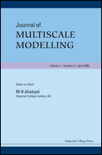
Journal of Multiscale Modelling
Bridging Scales for Enhanced UnderstandingWelcome to the Journal of Multiscale Modelling, a reputable publication dedicated to advancing the fields of Modeling and Simulation and Computer Science Applications. Published by World Scientific Publishing Co Pte Ltd in Singapore, this journal serves as a vital resource for researchers, professionals, and students seeking to explore the intricate relationships between various scales of modeling systems. Since its inception in 2009, the journal has established a pivotal role within the academic community, evidenced by its Q4 ranking in both its respective categories and its interests in contributing to the understanding of complex systems through innovative simulation techniques. With an ISSN of 1756-9737 and an E-ISSN of 1756-9745, the journal encourages submissions that push the boundaries of current knowledge and methodologies. Though currently not open access, articles published in this journal are recognized for their scholarly rigor and innovation, aiming to foster collaboration across disciplines and enhance the practical applications of multiscale modeling techniques in various industries. Join us in exploring the vast potentials of multiscale modeling that lie ahead.